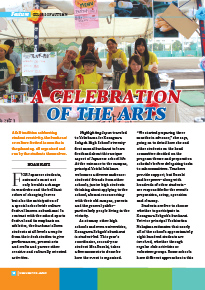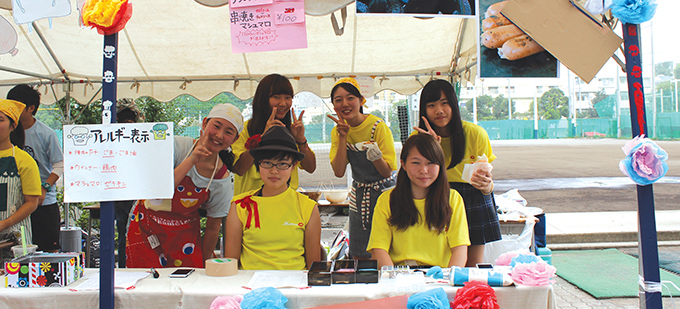Home > Highlighting JAPAN >Highlighting Japan November 2015>Colors of Autumn
Highlighting JAPAN

Colors of Autumn
A Celebration of the Arts
A fall tradition celebrating student creativity, the bunkasai or culture festival is months in the planning, all organized and run by the students themselves.

For Japanese students, autumn’s onset not only heralds a change in wardrobe and the brilliant colors of changing leaves but also the anticipation of a special schoolwide culture festival known as bunkasai. In contrast with the school sports festival and its emphasis on athletics, the bunkasai allows students at all levels a respite from their desk studies to give performances, present arts and crafts and pursue other creative and culturally oriented activities.
Highlighting Japan traveled to Yokohama for Kanagawa Sohgoh High School’s twenty-first annual bunkasai to learn firsthand about this unique aspect of Japanese school life. At the entrance to the campus, principal Yoichi Ichikawa welcomes a diverse audience: students’ friends from other schools, junior high students thinking about applying to the school, alumni reconnecting with their old campus, parents and the general public—particularly people living in the vicinity.
As at many other high schools and even universities, Kanagawa Sohgoh’s bunkasai is student-led. This year’s coordinator, second-year student Mea Suzuki, takes a few moments to describe how the event is organized. “We started preparing three months in advance,” she says, going on to detail how she and other students on the head committee decided on the program theme and preparation schedule before delegating tasks to subcommittees. Teachers provide support, but Suzuki and her peers—along with hundreds of other students—are responsible for the event’s preparation, setup, operation and cleanup.
Students are free to choose whether to participate in Kanagawa Sohgoh’s bunkasai. Yet vice principal Yoshimitsu Nakajima estimates that nearly all of the school’s approximately eight hundred students are involved, whether through regular club activities or volunteer groups. Some schools have different approaches in this regard, with festival activities based instead around student classes. Nevertheless, Nakajima notes, even those who do not take on a role still attend to cheer on their classmates.
A five-member dance group opens the day’s event with a lively hip-hop dance near the school’s entrance. In the central courtyard a jazz band plays Glenn Miller’s “In the Mood” to a throng of camera-toting fans. In the kyudo (Japanese archery) hall, guests wait patiently in a twenty-minute queue for a chance to practice the art under the guidance of kyudo club members. Students perform one after another on stage in the school’s main auditorium and on a smaller platform outside.
Closer to the sports field, delicious scents of food beckon visitors to investigate. Students are cooking and selling reasonably-priced treats that include savory okonomiyaki pancakes, cotton candy, and a rice cake sandwich of melted cheese and mochi (glutinous rice) sold by the swim club called suimasenbei (reportedly only available at Kanagawa Sohgoh). The bunkasai is not intended to be a moneymaking enterprise, but Suzuki says that any funds raised are first used to cover expenses and the rest donated to charity.
Nakajima guides us around the ten-story building that forms the school’s main campus. Classrooms on each floor have been transformed into art exhibitions, informal coffee shops, cultural exhibits, and even a haunted . . . classroom. A Kanagawa Sohgoh support teacher and alumnus, who was himself the bunkasai student coordinator seventeen years ago, has seen the bunkasai change over the years. “It’s much more organized now,” he says, “and the number of visitors has increased significantly, from three thousand to at least six thousand people.”
All too quickly it is lunchtime, and many visitors decide to stop by the swim club’s tent to purchase their popular suimasenbei. The large queue of hungry customers waiting there is one indication that this year’s bunkasai has been a resounding success.
© 2009 Cabinet Office, Government of Japan






